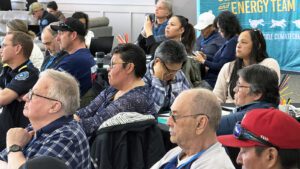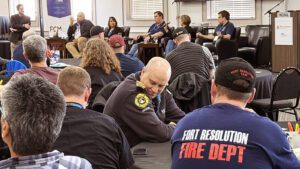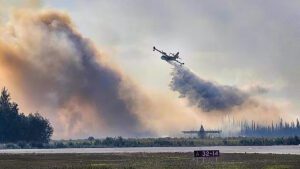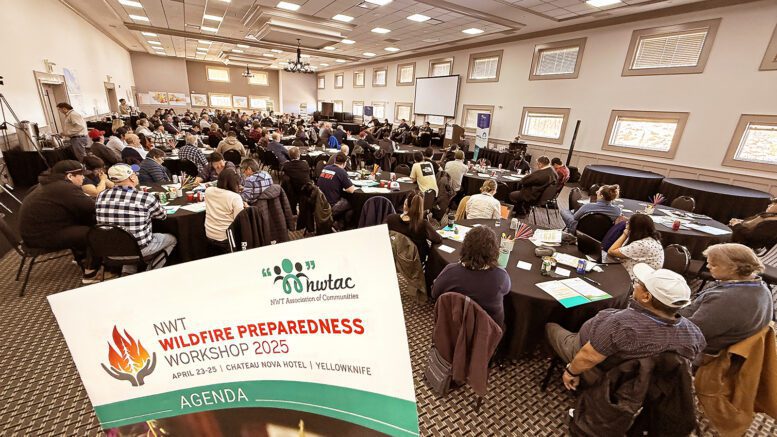The lessons learned from the historically devastating 2023 wildfire season are many, but questions remain as to how many will be put into action before the next natural disaster.
Representatives from all 29 forested communities in the NWT were invited to the first NWT Wildfire Preparedness Workshop this week in Yellowknife, to share their experiences, identify challenges and work together on solutions to enhance resilience to wildfires.
One panel discussion entitled, “Community experiences and learning from each other,” brought together five community leaders onstage in front a full conference room at the Chateau Nova Hotel.

Behchokǫ̀ SAO Pushp Seth, left, Tulita SAO Samantha Bayha, Fort Smith Director of Protective Services Adam McNab, Hay River Director of Protective Services Travis Wright, Hay River Mayor Kandis Jameson during panel entitled “Community experiences and learning from each other,” Wednesday at the NWT Wildfire Preparedness Workshop at the Chateau Nova Hotel. (James O’Connor/CKLB)
The panelists at the Northwest Territories Association of Communities event highlighted the importance of preparedness, collaboration, and mental health support for first responders.
Topics included:
- Review and update community emergency plans, including ensuring redundancy in critical services and roles.
- Collaborate with housing corporations and insurance providers to improve access to home insurance coverage, especially in Indigenous communities.
- Implement mental health support programs and peer-to-peer initiatives for firefighters and other emergency responders.
- Continue to invest in community-level fire mitigation efforts, such as fuel reduction, fire breaks, and FireSmart assessments
But the most repeated call was for the ability for communities to be able to effectively help each other through major events such as fires or floods.
“I think one thing that we’re hearing here … with the fire departments and through the NWT Fire Chiefs Association, is that we want to be able to help each other through these events if someone gets into trouble,” said Travis Wright, Hay River’s director of protective services.

The NWT Wildfire Preparedness Workshop at the Chateau Nova Hotel. (James O’Connor/CKLB)
“The more we can work together, cross train, and hopefully get a program in place, we’ll be able to help each other in those times of need, because we certainly needed it.”
With Hay River evacuated, the wildfires that had earlier in the summer razed several buildings in neighbouring Kátł’odeeche First Nation pushed their way right to the town’s borders.
That’s when an Alberta firefighter training program that integrates wildfire resources across the province came into play.
The Wildland Urban Interface (WUI) Structural Protection Team program trains firefighters to be prepared to respond to both wildland and urban emergencies.
WUI resources based in High Level, Alberta, entered the NWT at the height of the blazes and drove all night to Hay River to help save the territory’s second-largest community.

The NWT Wildfire Preparedness Workshop at the Chateau Nova Hotel. (James O’Connor/CKLB)
Wright added: “The talk about bringing WUI to the Northwest Territories is something that we all want to see, and I think it’s the biggest change that our fire service needs to go through, so that we can work together and be more prepared as a community.
‘We wouldn’t have been able to manage that fire alone in August (2023) without those (WUI) resources — that made the difference between a lot of our community standing — we had many challenging days.”
Mayor Kandis Jameson was blunt: “The only reason that Hay River is still Hay River is because of Wildland Urban Interface. It really is. We need that here. I think of some of our smaller communities that have a volunteer fire department: What do you do if something goes wrong?”
Last summer, Hay River’s Fire Department organized a Wildland Urban Interface Structure Protection training course in the community.

The NWT Wildfire Preparedness Workshop at the Chateau Nova Hotel. (James O’Connor/CKLB)
As Hay River South MLA Vince McKay noted at the time, trainers from the High Level Fire Department in Alberta led the course, which was also attended by fire departments from Fort Simpson and Fort Smith.
The consensus was to advocate for the development of a comprehensive WUI program in the Northwest Territories to provide training, equipment, and coordination for communities.
During the Q&A session, a member of the audience asked about mental health supports for emergency personnel and community officials who were on the front lines.
Wright noted the Northwest Territories Fire Chiefs Association — of which he is acting president — has just partnered with Wounded Warriors Canada for mental health training and counselling programs, along with culturally specific and trauma-informed supports available to first responders and their families.
“So, we’re just trying to plan when we’re going to be putting the sessions on to train those people, and then be able to launch an app for firefighters to support each other, which is something I think we’ve always been missing in the territories.”

An air tanker drops water on the massive blaze encircling Hay River in 2023, with the town’s airport runway in the foreground. (Photo courtesy of NWT Fire)





